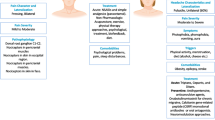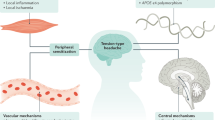Abstract
For years clinicians and researchers have debated the nosology of headache generally and of “migraine” versus “tension-type headache” in particular, an exhaustive process that arguably has done little to improve patient management and clinical outcome. New research data now indicate that the migraine versus tension-type distinction indeed may possess some clinical use, because patients with migraine or “mixed” headache syndromes may respond differently to a specific therapeutic intervention than patients with “pure” tension-type headache. This variable response to treatment intervention would seem to imply that similarly distinctive biologies are generating the respective headache syndromes, but to date we have insufficient evidence to support that conclusion.
Similar content being viewed by others
References and Recommended Reading
Ad Hoc Committee on Classification of Headache: Classification of headache. JAMA 1962, 179:717–718.
Classification and diagnostic criteria for headache disorders, cranial neuralgias and facial pain. Headache Classification Committee of the International Headache Society [no authors listed]. Cephalalgia 1988, 8(suppl 7):1-96.
Wolff HG, Tunis MM: Analysis of cranial artery pressure pulse waves in patients with vascular headache of the migraine type. Trans Assoc Am Physicians 1952, 65:240–244.
Welch KMA: Migraine: a biobehavioral disorder. Arch Neurol 1987, 44:323–327.
Noack H, Rothrock J: Migraine: definitions, mechanisms, and treatment. South Med J 1996, 89:762–769.
Sicuteri F, Testi A, Anselmi B: Biochemical investigations in headache: increase in the hydroxyindoleacetic acid excretion during migraine attacks. Int Arch Allergy 1961, 19:55–58.
Ferrari MD, Odink J, Bos KD, et al.: Neuroexcitatory plasma amino acids are elevated in migraine. Neurology 1990, 40:1582–1586.
Humphrey PPA: 5-Hydroxytryptamine and the pathophysiology of migraine. J Neurol 1991, 238(suppl):38–44.
Rothrock JF, Mar KR, Yaksh TL, et al.: Cerebrospinal fluid analyses in migraine patients and controls. Cephalalgia 1995, 15:489–493. The authors presented clear evidence that migraine reflects disordered central neurotransmission, that this abnormality is present in all clinical phenotypes of migraine, and that prophylactic treatment of migraine may produce clinical improvement, which is paralleled by at least partial correction of the predisposing biologic abnormality.
Schoenen J: Cortical electrophysiology in migraine and possible pathogenetic implications. Clin Neurosci 1998, 5:10–17.
Aurora SK, Cao Y, Bowyer SM, Welch KMA: The occipital cortex is hyperexcitable in migraine: experimental evidence. Headache 1999, 39:469–476.
Weiller C, May A, Limmroth V, et al.: Brainstem activation in spontaneous human migraine attacks. Nat Med 1995, 1:658–660.
May A, Bahra A, Buchel C, et al.: Hypothalamic activation in cluster headache attacks. Lancet 1998, 352:275–278.
Ophoff RA, Terwindt GM, Vergouwe MN, et al.: Familial hemiplegic migraine and episodic ataxia type-2 are caused by mutations in the Ca2+ channel gene CACNL1A4. Cell 1996, 87:543–552.
Ducros A, Denier C, Joutel A, et al.: Recurrence of the T666M calcium channel CACNA1A gene mutation in familial hemiplegic migraine with progressive cerebellar ataxia. Am J Hum Genet 1999, 64:89–98.
Shukla R. Shanker K, Nag D, et al.: Serotonin in tension headache. J Neurol Neurosurg Psychiatry 1987, 50:1682–1684.
Anthony M, Lance JW: Plasma serotonin in patients with chronic tension headaches. J Neurol Neurosurg Psychiatry 1989, 52:182–184.
Leira R, Castillo J, Martinez F, et al.: Platelet-rich plasma serotonin levels in tension-type headache and depression. Cephalalgia 1993, 13:346–348.
Featherstone HJ: Migraine and muscle contraction headaches: a continuum. Headache 1985, 25:194–198.
Schwartz BS, Stewart WF, Simon D, Lipton RB: Epidemiology of tension-type headache. JAMA 1998, 279:381–383.
Raskin NH: Headache, edn 2. New York: Churchill Livingstone; 1988.
Celentano DD, Stewart WF, Linet MS: The relationship of headache symptoms with severity and duration of attacks. J Clin Epidemiol 1990, 43:983–994.
Rasmussen BK, Jensen R, Olesen J: A population-based analysis of the diagnostic criteria of the International Headache Society. Cephalalgia 1991, 11:129–134.
Ferrari MD, Odink J, Bruyn GW: Biochemical differences between classic migraine, common migraine and tension headache. In New Trends in Clinical Neurology: Migraine and Other Headaches. Edited by Ferrari MD, Lataste X. Carnforth, NJ: Parthenon; 1989:151–160.
Ferrari MD, Odink J, Frolich M, et al.: Release of platelet MET-enkephalin, but not serotonin, in migraine. J Neurol Sci 1989, 93:51–60.
Ferrari MD, Odink J, Tapparelli C, et al.: Serotonin metabolism in migraine. Neurology 1989, 39:1239–1242.
Ferrari MD, Odink J, Frolich M, et al.: Methionine-enkephalin in migraine and tension headache. Differences between classic migraine, common migraine and tension headache, and changes during attacks. Headache 1990, 30:160–164.
Weihe E, Schafer MK, Nohr D, Persson S: Expression of neuropeptides, neuropeptide receptors and neuropeptide processing enzymes in spinal neurons and peripheral non-neural cells and plasticity in models of inflammatory pain. In Neuropeptides, Nociception and Pain. Edited by Hokfelt T et al. London: Chapman & Hall; 1994:43–69.
Ashina M, Bendtsen L, Jensen R, et al.: Plasma levels of calcitonin gene-related peptide in chronic tension-type headache. Neurology 2000, 55:1335–1339.
Johannes CB, Linet MS, Stewart WF, et al.: Relationship of headache to phase of the menstrual cycle among young women: a daily diary study. Neurology 1995, 45:1076–1082.
Guitera V, Munoz P, Pascual J, et al.: Prevalence and diagnostic distribution of chronic daily headache in the general population. Cephalalgia 1997, 17:283.
Silberstein SD, Lipton RB: Classification of daily and near daily headache: field trial of revised IHS criteria. Neurology 1996, 47:871–875. The authors took on the “dark continent” of chronic daily headache (CDH), proposed a new diagnostic classification system, and field tested their system. Their results offer nothing less than a new language for exploring and treating CDH.
Rothrock J, Patel M, Lyden P, Jackson C: Demographic and clinical characteristics of patients with episodic migraine versus chronic daily headache. Cephalalgia 1996, 16:44–49.
Cady RK, Gutterman D, Saiers JA, Beach ME: Responsiveness of non-IHS migraine and tension-type headache to sumatriptan. Cephalalgia 1997, 17:588–590.
Lipton R, Stewart W, Cady R, et al.: Sumatriptan for the range of headaches in migraine sufferers: results of the Spectrum Study. Headache 2000, 40:783–791. The first study to demonstrate convincingly that patients with an established diagnosis of IHS migraine will respond to acute treatment with oral sumatriptan regardless of the clinical characteristics of the particular attack being treated.
Rothrock J, Kelly NM, Brody ML, Golbeck A: A differential response to treatment with divalproex sodium in patients with intractable headache. Cephalalgia 1994, 14:241–244.
Mathew N, Ali S: Valproate in the treatment of persistent chronic daily headache. Headache 1991, 31:71–74.
Author information
Authors and Affiliations
Rights and permissions
About this article
Cite this article
Rothrock, J.F. What’s in a name? tension-type headache versus migraine. Current Science Inc 5, 463–466 (2001). https://doi.org/10.1007/s11916-001-0058-2
Issue Date:
DOI: https://doi.org/10.1007/s11916-001-0058-2




